Whether it’s an epic road trip you’ve been planning for months or a simply drive to work, an emergency that has you stuck on the roadside basically sucks the fun out of everything and puts a spanner in the works. Unfortunately, a lot of drivers don’t think that much about what they would do in this sort of situation. And if they eventually end up with an emergency situation on the road, they might end up making a bunch of mistakes, or being stuck longer than they would have been had they been better prepared.
If you have to hit the roadside due to a problem with your vehicle, then here are the things you need to keep in mind. Hopefully you’re reading this before anything happens, and not on your smartphone during a roadside emergency!
Get far away from other cars – but keep it visible
If you didn’t get a chance to drive your car off of the road before it stopped functioning, then you may have to get out and push it! However, you need to be very careful with how you approach this – in most scenarios, it’s advised that you don’t do it at all. While getting your car off the road is the safest thing for you, other drivers, and your car, the actual process of getting out and moving your car manually may not be the safest thing in the world! If the road is clear and you can see clearly for a long distance in both directions, then go for it. It’s essential that you know how to push your car safely before this sort of thing happens. However, if you’re on a busy road you should simply stay inside your vehicle and await help.
It’s best to get your car as far away from moving vehicles as possible. This being said, you don’t want to obscure your vehicle too much, especially if there’s a reasonable chance that a car could veer slightly off-road and hit it. Make sure people know that something has gone wrong by putting on your hazard lights. If you happen to have any emergency triangles with you, consider placing these around your vehicle!
Calling for assistance
In the vast majority of cases, the problem you’re dealing with is going to be some complex engine problem that you’re probably not going to have much luck with if you try to repair it yourself. So you’re going to have to call the experts. This is why you need to make sure you have a contract with a professional roadside assistance company; calling the big names for assistance in an emergency usually won’t get you anywhere if you’re not a member of their brand. There are usually several options for you if you need roadside assistance without a membership, so use the Internet search functions on your phone to find a local company willing to help.
However, if your phone is dead, then you’re going to have a hard time calling anyone, right? In such a scenario, you’re going to have to look for alternative means of getting assistance. Attempting to flag down other drivers could be your best bet; there’s a chance that they’ll have some equipment that will help you get back on the road, though the most likely form of help is that they’ll have a mobile phone you can use. There is always the possibility of hitchhiking to a nearby service station, though this really is something you should do only as a last resort, as it comes with many inherent dangers. Not least of all is the fact that you’ll be leaving your vehicle, which isn’t exactly highly recommended in this sort of situation! If you’re on a particularly popular road, then there will probably be police or even a highway patrol passing by at some point. They can be flagged down for some form of assistance.
Make use of your emergency kit
You should look into what the most common causes of vehicle breakdowns are, and then use that knowledge to equip your car correctly. Dead batteries are a common problem, so getting a portable jump starter, otherwise known as a battery booster, should be a priority. You can check out Tool Nerds battery booster comparisons if you’re interested. Damaged or flat tires are another common problem, so having a spare tire and the tools to install it is definitely recommended. Aside from these sorts of tools, you’ll also want to ensure you have a charged cell phone, a blanket, a flashlight, and possibly a first aid kit.
Leave it to the professionals
The best form of help you’re going to get is from roadside assistance professionals. Once they’ve arrived on the scene, it’s best to just allow them to get on with it. A lot of drivers make the mistake of trying to get too involved in the process. While the experts who have arrived will probably want to know some information about the vehicle and the defect, they’ll work better when left to simply do their job. They are the experts in this field, after all!
Don’t be tempted to distract them too much with idle chitchat. You also need to ensure that you’re patient. While you’re going to be understandably frustrated and eager to get back to whatever it is you were trying to do, the whole thing is basically out of your hands now. If your car needs to be towed to another location in order to get a proper fix carried out, then don’t object; this just wastes time. Ensure you call anyone who might be waiting for you so they know a) what’s going on and b) that you’re okay!






